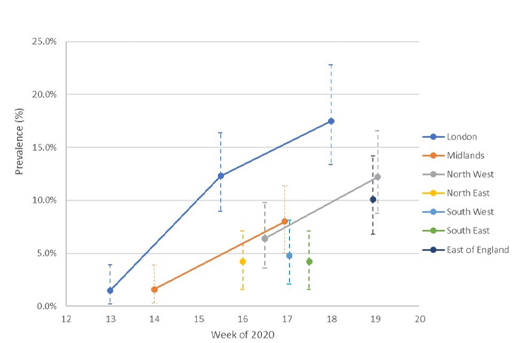2.3 Seroprevalence
Seroprevalence is a measure of the prevalence of antibodies against an infectious agent. As you discovered in Weeks 3 and 4, this can provide useful information about levels of immunity in the population. In large studies it can also provide regional information. One of the first large-scale studies on COVID-19 antibodies took place in Spain in April – May 2020 and was reported in The Lancet. Figure 3 shows the seroprevalence of IgG antibodies against the SARS-CoV2 nucleocapsid protein, in different regions of the country. It is clear that the levels of infection in the central regions, including Madrid, were much higher than in the peripheral areas.
Seroprevalence can also be used to track changes in immunity across time. Figure 4 shows the percentage of samples having antibodies to SARS-CoV2 spike protein, from blood donors in different regions of the UK. The donations were screened by an ELISA (Euroimmun) which is similar to the one you carried out in Week 4. Notice that the time of this study covers the period from April to May 2020, when the UK vaccination programme was fully active. The progressive increase in antibodies against spike protein in blood donors, therefore, primarily reflects the increasing proportion who had been vaccinated.
Serology can also give information about the proportion of people who are infected but asymptomatic. In the study in Spain, noted above, and in other studies across Europe including Iceland it was found that 30−40% of people who had antibodies against SARS-CoV2 had reported no symptoms and mostly had not been tested for infection by PCR.
A major difference between SARS-CoV2 and the original SARS is the high proportion of asymptomatic cases, which meant that it was much more difficult to identify and isolate infected people, to prevent transmission.


